Sauropods are well known group of dinosaurs for good reasons: they are the largest land animals to roam the planet and their long necks and tails make them easily recognizable. But not all sauropods are created equal, some are small and don’t have the long necks that have defined the group. The sauropod family known as dicraeosaurids , a sister group to the more familiar Diplodocidae, breaks from this typical sauropod image in many ways. Like their sister group the Diplodocoids, dicraeosaurids heyday was in the Jurassic although some would make it all the way to the Early Cretaceous. Today we will take a look at one member of the family Dicraeosaurid.
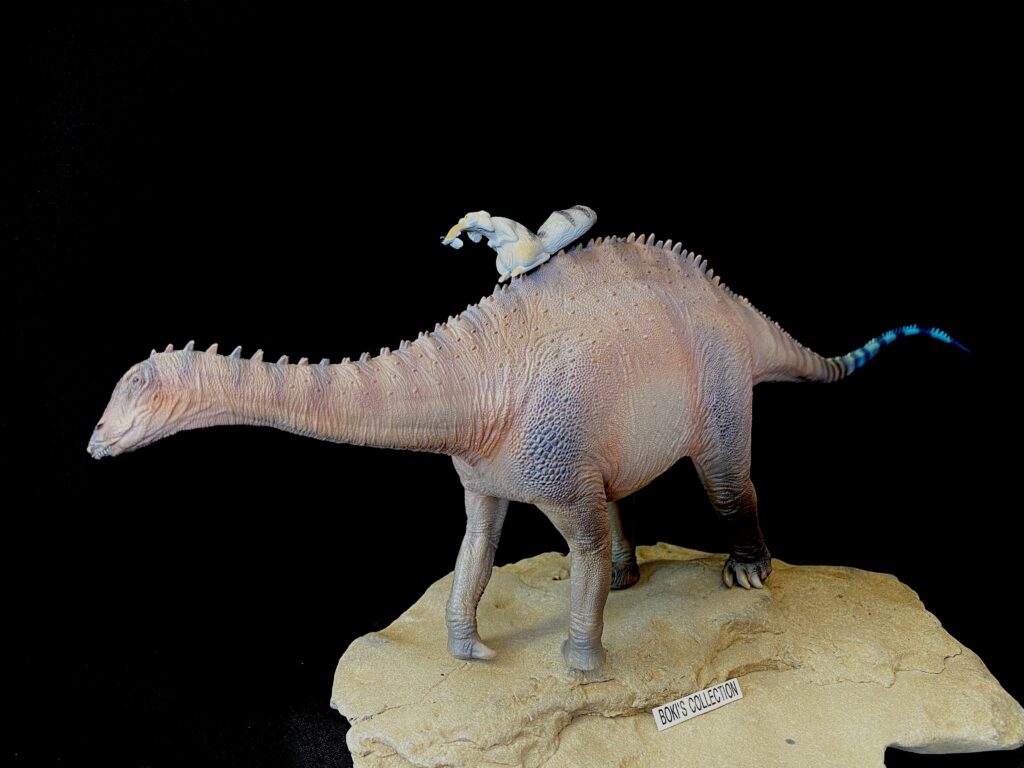
Lingwulong shengi or literally “amazing dragon from Lingwu” is dicraeosaurid sauropod from the Early/Middle Jurassic of China’s Yanan Formation. If you are not familiar with it, I don’t blame you for it at all since the family as a whole are not well known and often overlooked with the exception of one member: Amargasaurus.
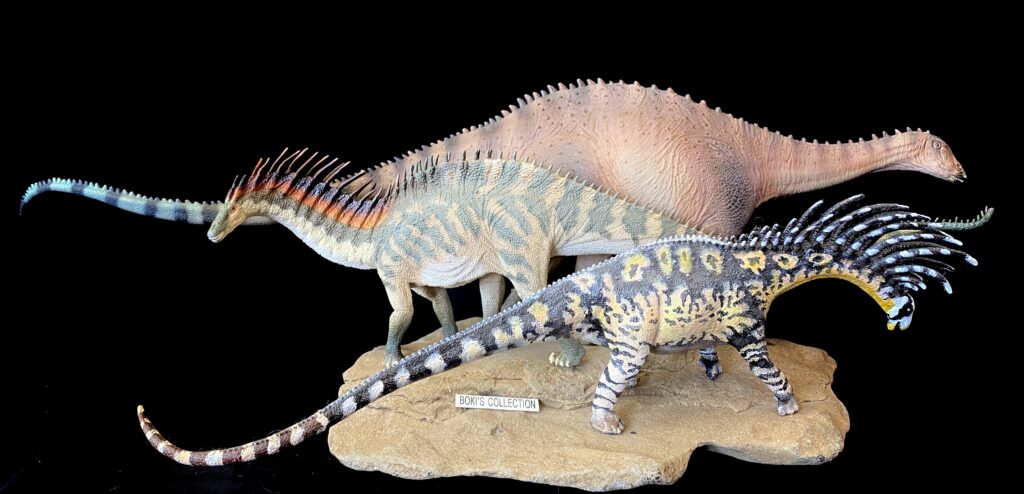
With its impressive double rows of tall neck spines, Amargasaurus has captivated the public’s (as well as toy/model makes) attention and kept it in the spotlight, making it the most famous member of the family and a favorite with toy figure makers. The newly discovered relative, Bajadasaurus, looks similar to Amargasaurus but with its rows of neck spines oriented forward in a spectacular way, is threatening to share the spotlight from its famous cousin. All the other members of the group are obscure with hardly any figure representation although a Dicraeosaurus was recently produced by GR Toys (which I unfortunately was not able to secure at a reasonable price).
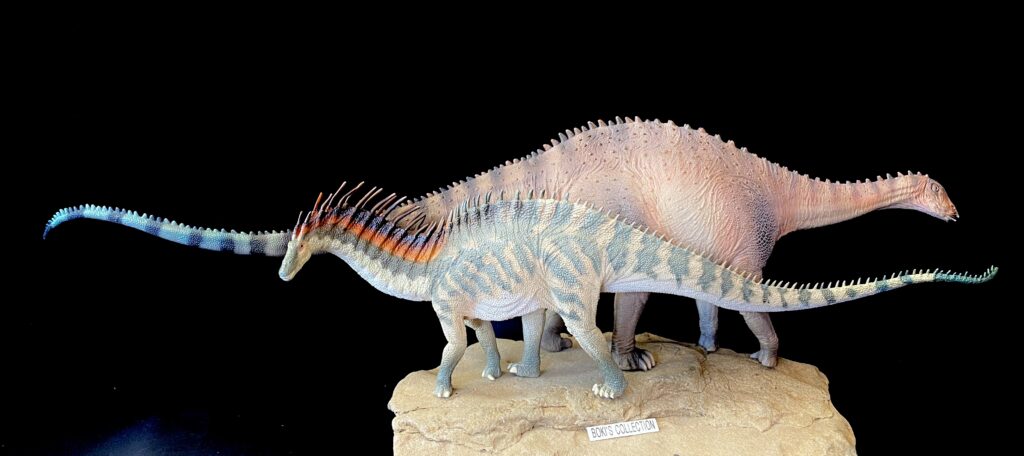
PNSO’s new model of Lingwulong is a wonderful addition that hopefully would allow this overlooked group some well-deserved attention. It’s been a long time since we saw a sauropod from PNSO that is not Amargasaurus or Mamenchisaurus. As fans waited for years for a new sauropod there were questions as to what a new sauropod from them would look like. Would it be hollow like their first models or would it be downsized to a much smaller size like the latest incarnation of Mamenchisaurus? Well, the wait is over and thankfully the model is one solid chunk of plastic and is done at the popular 1:35 scale! Being solid it has some weight to it and easily one of the heaviest and largest model from PNSO within the last 3 years. In the PNSO tradition this model is given the name Chuanchuan.
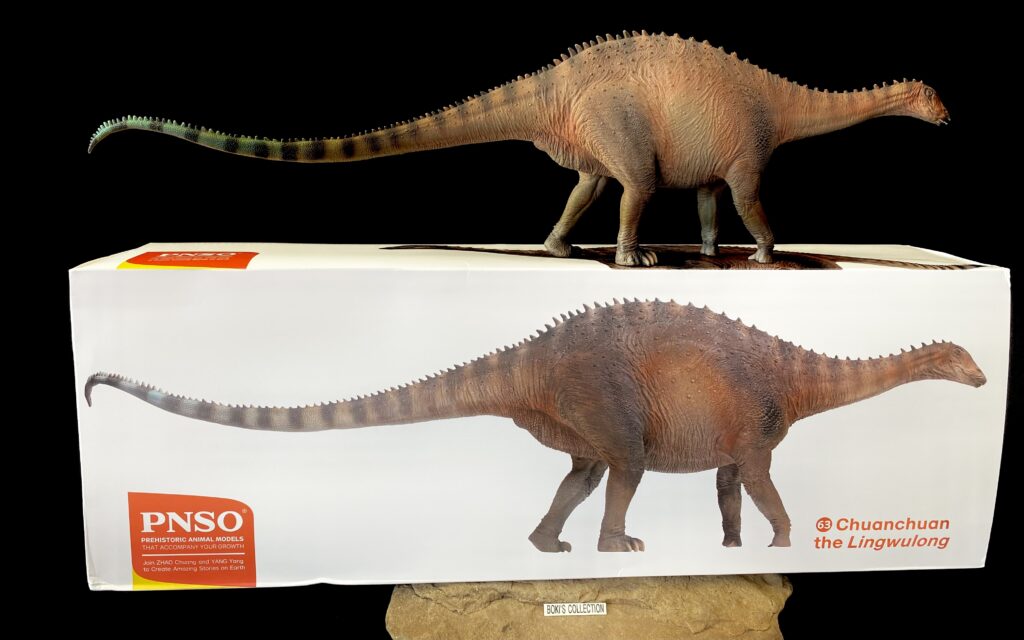
Lingwulong was officially named and described very recently in 2018. It was discovered in 2004 by a sheep herder, the fossil remains consisted of several partial skeletons from multiple individuals. Some included part of the skull, a rarity in sauropods, as well the majority of the body and limbs making Lingwulong one of the most complete sauropods known. This near completeness makes restoring it easier and gives us a pretty good idea of what the animal may have looked like. It is also worth noting that Lingwulong is the only definitive dilplodocoid sauropod from East Asia and one of the earliest. Dicraeosaurid sauropods have been found in North America, Africa, Asia, and South America and includes genera such as Amargasaurus,Suuassea,Dicraeosaurus, Brachytrachelopan, Bajadasaurus, and of course our subject today Linwulong.

In general members of the dicraeosauridae have shorter necks, a shorter more compact body, and tall neural spines than other sauropods. As a result, they have an oddly proportioned body shape that is very unique. Given how unusual these sauropods are and their medium size, it’s puzzling that many companies have not taken notice and produced more models of the various genus. Lingwulong is one ,if not the, largest of the group with an estimated size of 19 to 20 meters long.
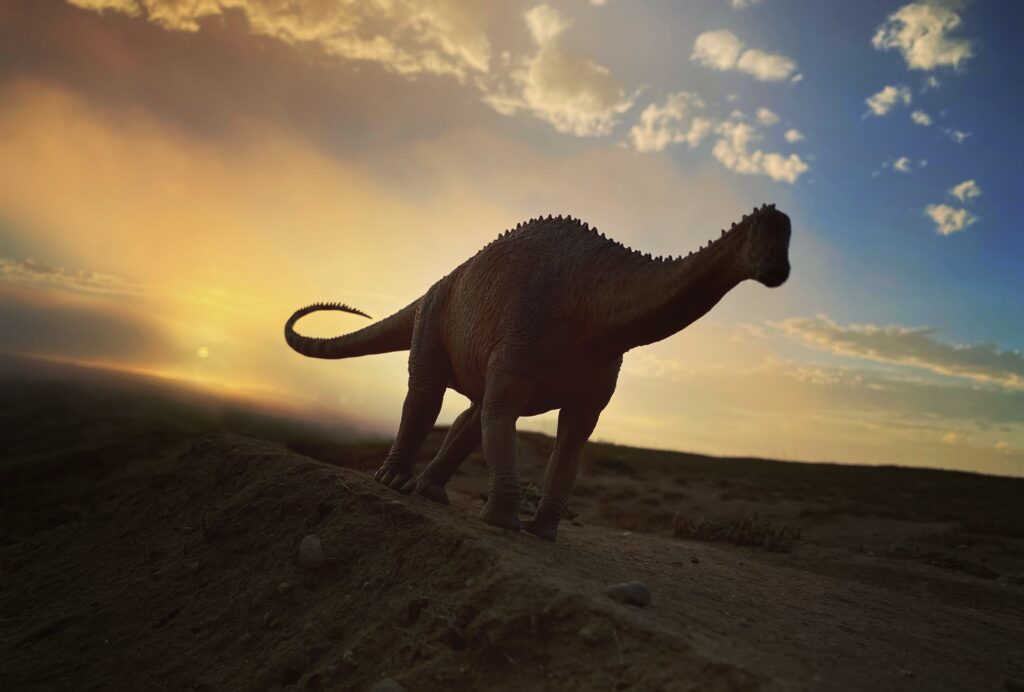
First, the size. This model unlike the downsized Mamenchisaurus, is big and solid, something we have been missing in sauropod figures released within the last four years. The figure is done at the popular 1:35 scale measuring almost 20” inches long and 6” inches tall at the highest point which is the hips. The tail is long making up half the length at 11” inches inches! The figure definitely has that impressive presence that sauropod model should have.


The pose is as active as it could get where sauropod are concerned. The neck has a slight curve towards one side as if the animal is looking back. The legs are firmly planted on the ground but are animated as if the animal is frozen mid-stride. The long tail has a nice fluid motion to it as it sways side to side and the tips flick like the tip of a whip.
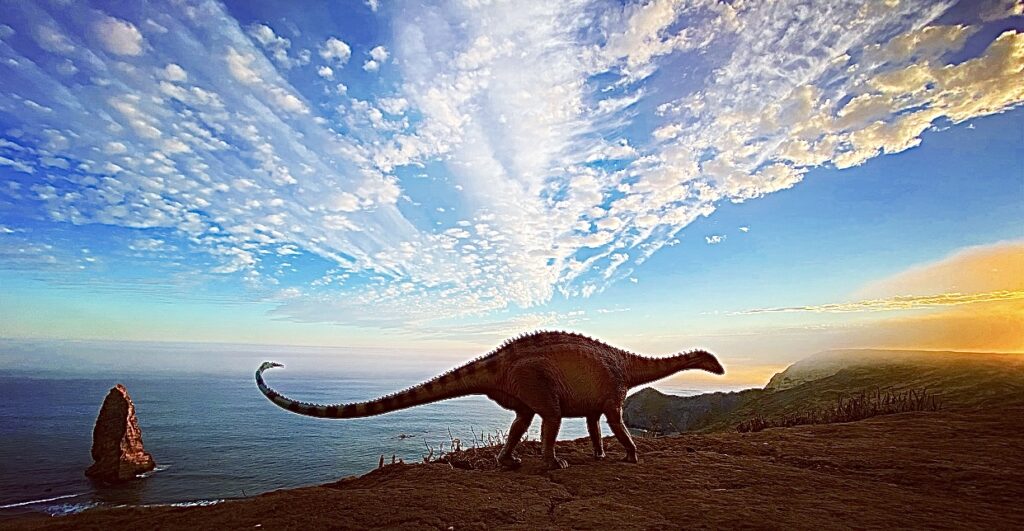
The neck is short and muscular as it should be and looks more like something we see on a stegosaurus than a sauropod. The head is beautifully sculpted with plenty of details to examine and admire. Scales of varying sizes as well as skin folds are all delicately done yet remains very crisp. The mouth has what looks like a keratin beak something we don’t often see in sauropod models but appears to be gaining some popularity and yes, even lips .
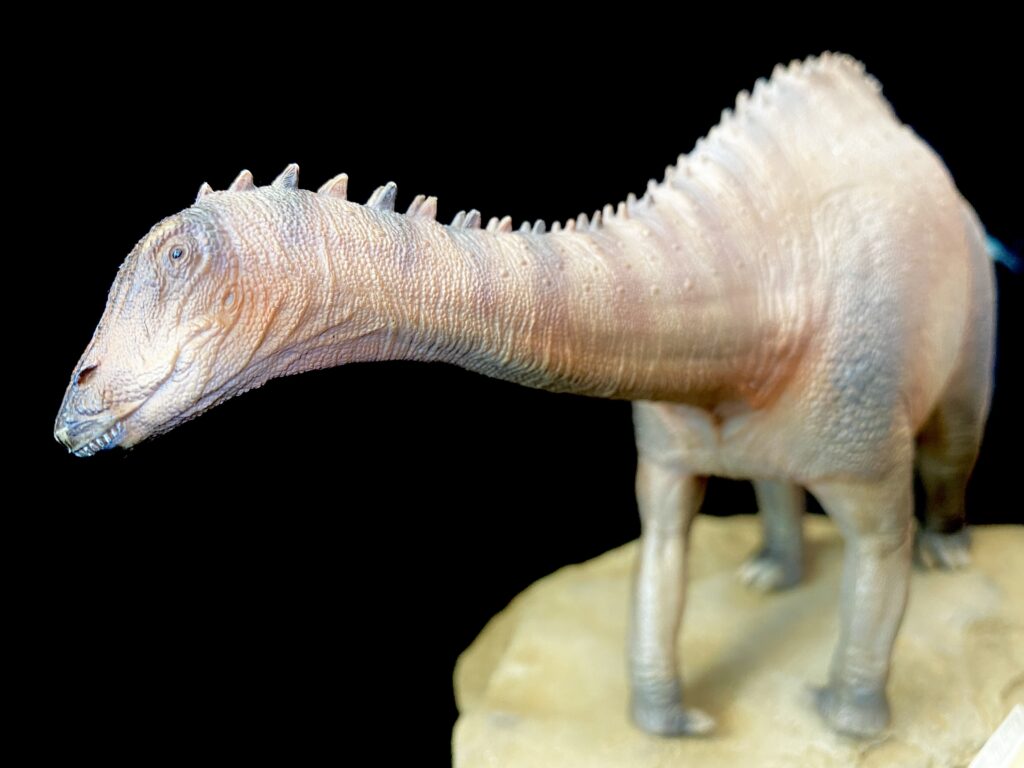
The teeth are small and individually sculpted and painted cleanly. The teeth sticks out a bit and are visible, this is something that some people were critical about but to me does not looks out of place after all sauropod teeth are odd and often oriented in a weird way, plus the visible teeth actually add some character to the face like a happy puppy. The eyes are small and painted black with plenty of delicate wrinkles surrounding it; the bunched up wrinkles just behind the eyes are especially nice and suggest tension on the skin.

Starting at the back of the head, a paired row of short spines begin and run all the way down the back until it reaches the middle point in which they merge into a single row. At this point the spine grow larger in size as they continue down the back all the way down the tail. These dorsal spines show variations in size as well as shape which add some interest.The body is robust, compact, and high, typical trait of this group of sauropods. The stomach is appropriately rotund and well defined by the skin and musculature around it.
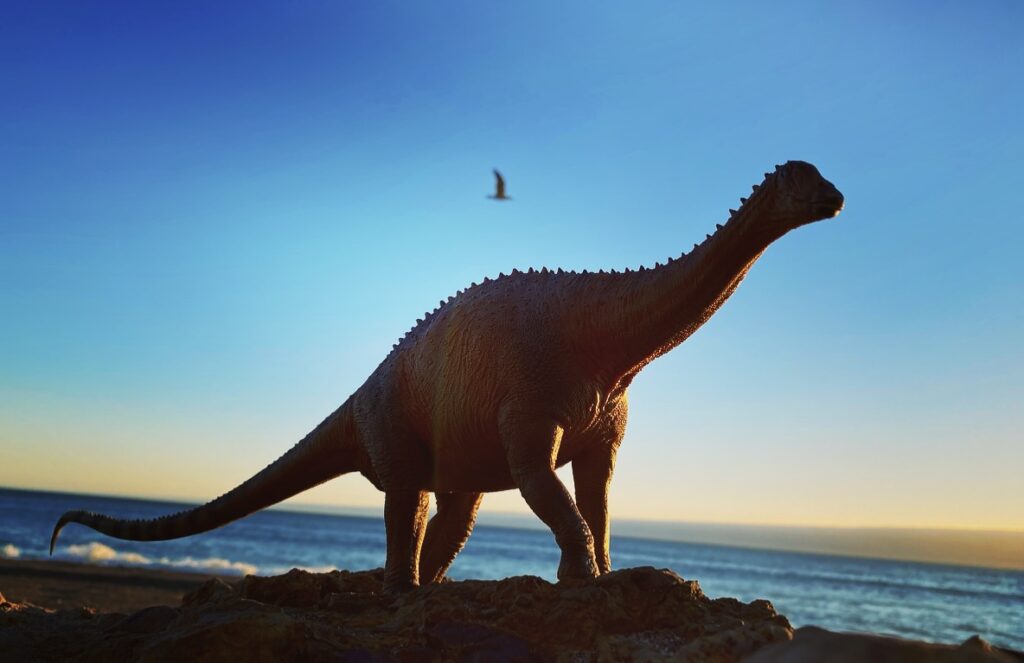
By now we are used to the exquisite details seen on PNSO models and this one showcases all of this in spectacular way. The skin folds follows each muscle form and orientation that really gives the model that great sense of movement and tension . The musculature is top notch as expected. PNSO, in my opinion, has really mastered the art of skin and scales rendered and sculpting. While they have been criticized in the past for some oversized scales on some of their models, they are quick to correct those and we see improvement with each new models. This model showcases such improvements and refinement. Each scales are individually sculpted and show great variations in size and shape that fits the location on the body.
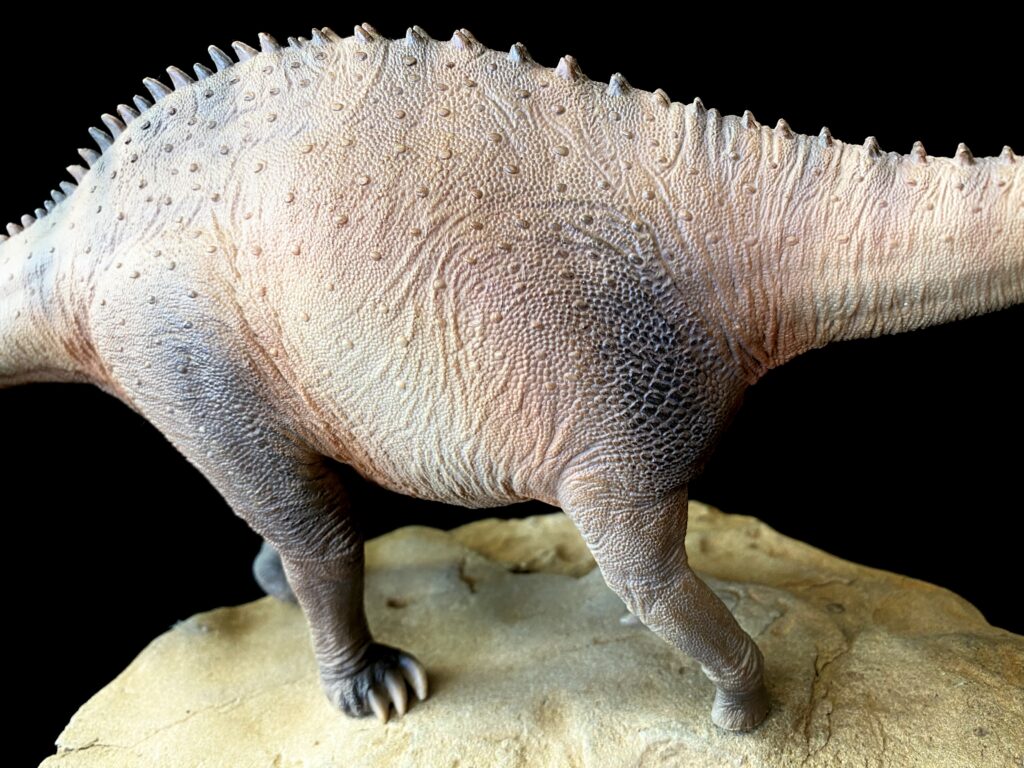
The entire body is covered by very small scales and you won’t see any “cross hatching “ lines that we often see done on sauropod models. Instead you see delicately sculpted skin fold covered by small scales. Peppering the body are larger sized scales or osteoderms that adds texture. The shoulder area is covered in thicker and larger scales of various shapes and sizes that together form an armor of some type which is really cool and unique. You see something similar happening on the thighs area but not as concentrated.
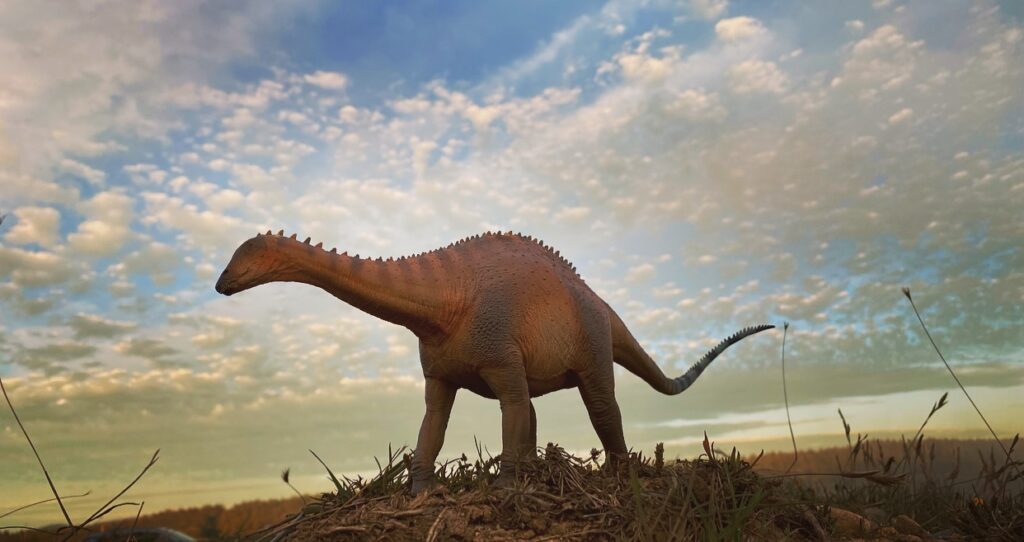
The belly is full of loose skin as well as folds and wrinkles that really suggest weight and movement. The legs show remarkable details as well even down to tendons and veins , all finely sculpted. The front feet has the correct shape and show the enlarged thumb claw, and if you look under the foot, you will see that even this area that is typically not visible is given details in the form of scales.
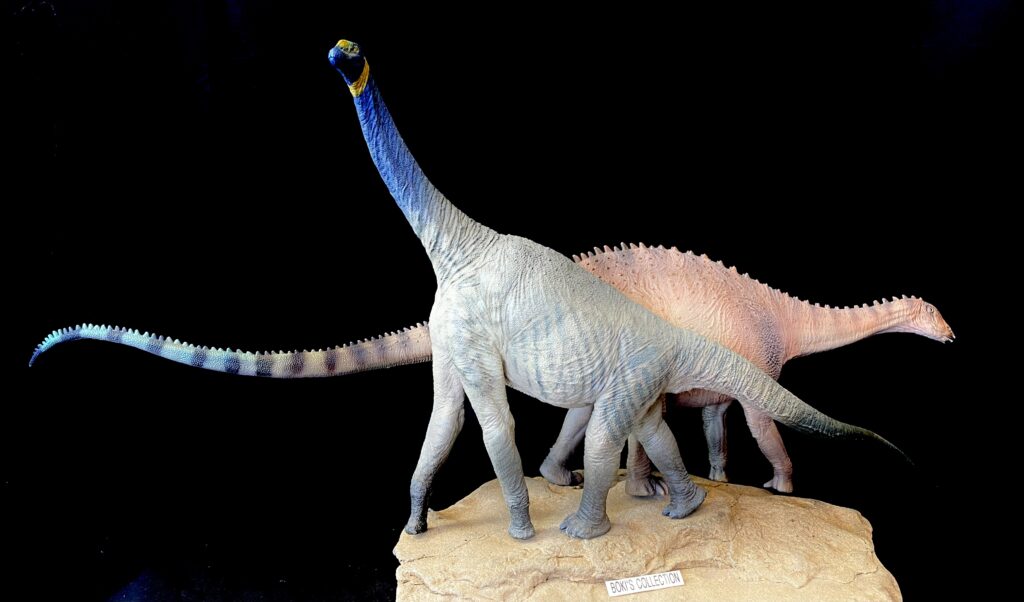
The tail base is muscular as it should be and show great skin folds and wrinkles. It is long and showing the typical whip-like flexibility that is seen on its sister group the diplodocus. The tail gently curved downwards until it is parallel with the belly and it is at this height that it is held until it reaches the tip where it then curves sideways in a pleasing way that captures movement.
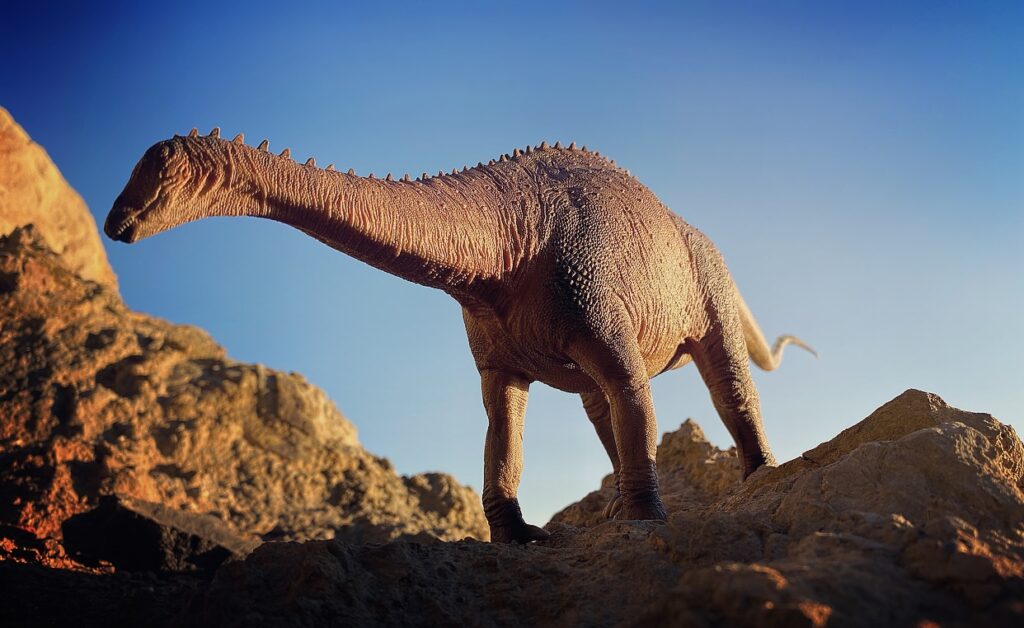
Reviewing lots of PNSO models, after a while you start to run out of creative ways to describe the masterful ways that the pain application is done. Let’s face it, when it come to paint application and flawless transitioning of colors, there is not much competition. And just when you think that PNSO has improved on the last model, a new one such as this show even more refinement.
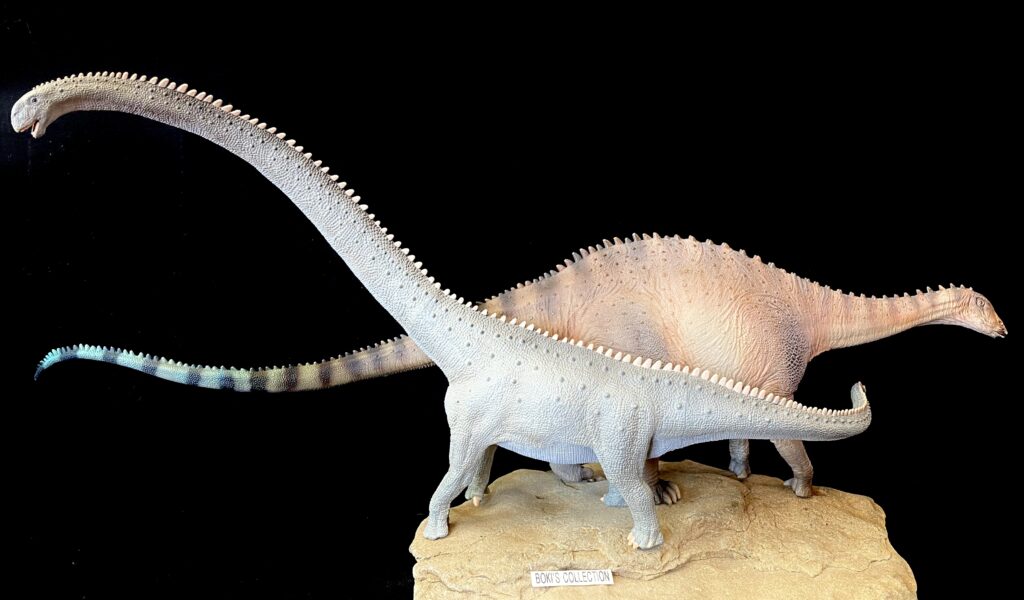
The base colors are dark or rust brown but like most PNSO models, the colors are more complex and intricate than meets the eyes at first glance. Various tones and shades of brown, gold, yellow, beige, white, and black are blended together creating a seamless and harmonious color scheme that looks natural and visually pleasing.
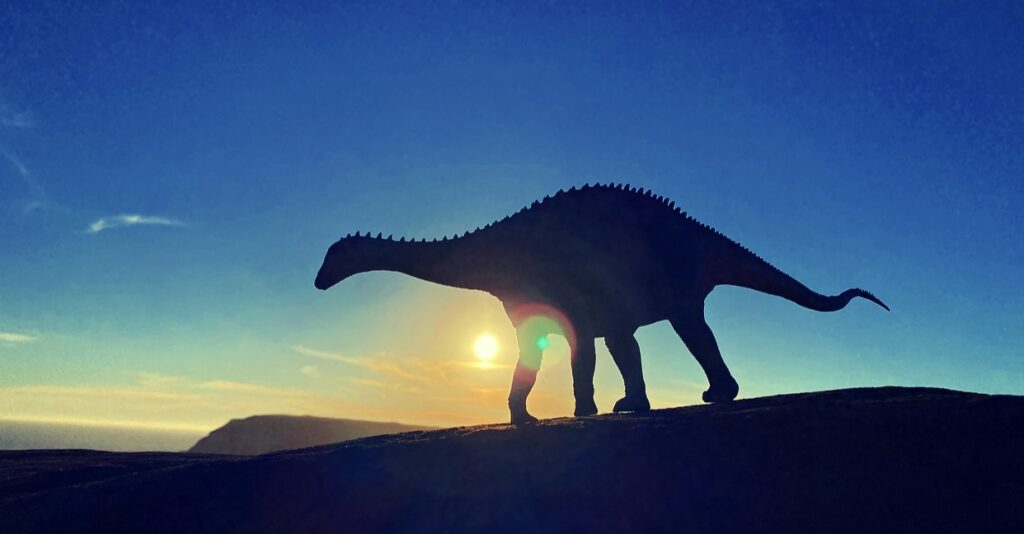
Each colors collide with each other in subtle transition that is barely noticeable. On the back you will see dark brown intersecting with a lighter tone creating stripes. The larger scales located on the shoulders are meticulously given a darker tone that really brings out the details of each scale and done so cleanly that it almost looks as if each of these scales were individually painted!
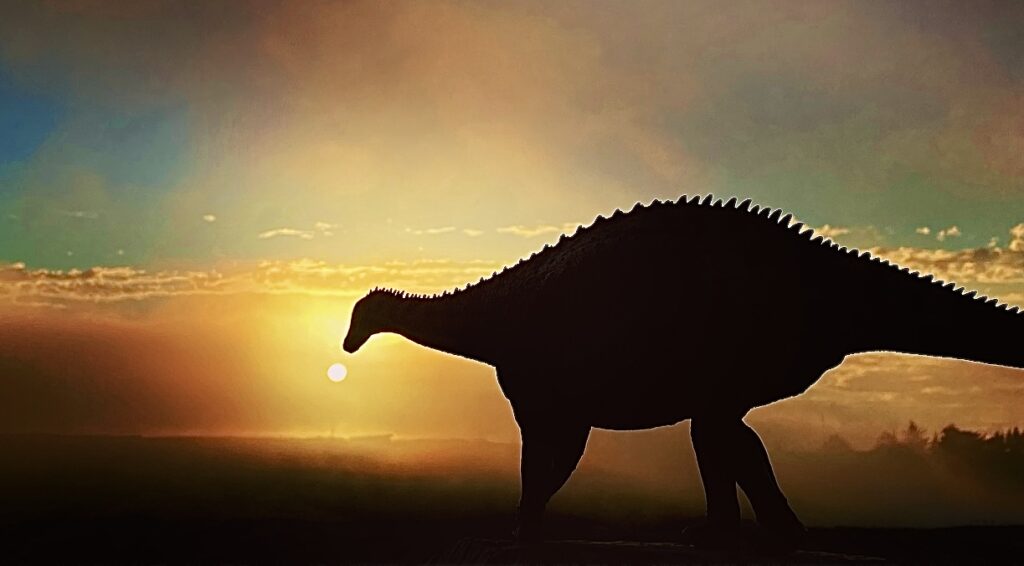
As it reaches the tail these strips become wider and soon form bands that adorn the entire tail. Starting midway at the tail, the brown colors starts to transition into an almost grayish tone before it then starts to change into a slate blue, turning lighter as it reaches the tips. This bluish hue is subtle yet very effective and eye catching, adding complexity and interest to this tapestry of earth tone colors. It is worth noting that the vibrancy of the blue change depends on lighting, the brighter the light the more vibrant the blue becomes.
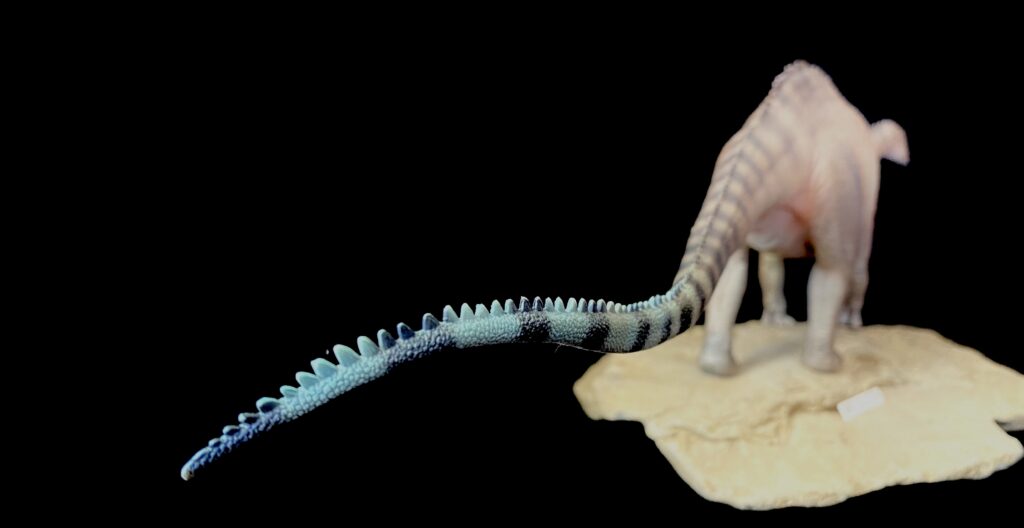
PNSO has hit a home run with this beautiful Lingwulong model. It is really full of details that would keep you busy as you admire each one of them in person. I find myself holding this large model, admiring the craftsmanship as well as the pleasing tactile feel of all these details as you run your fingertips through each surface. With this model, there is hope that the age of large sauropod models may not be a thing of the past after all.
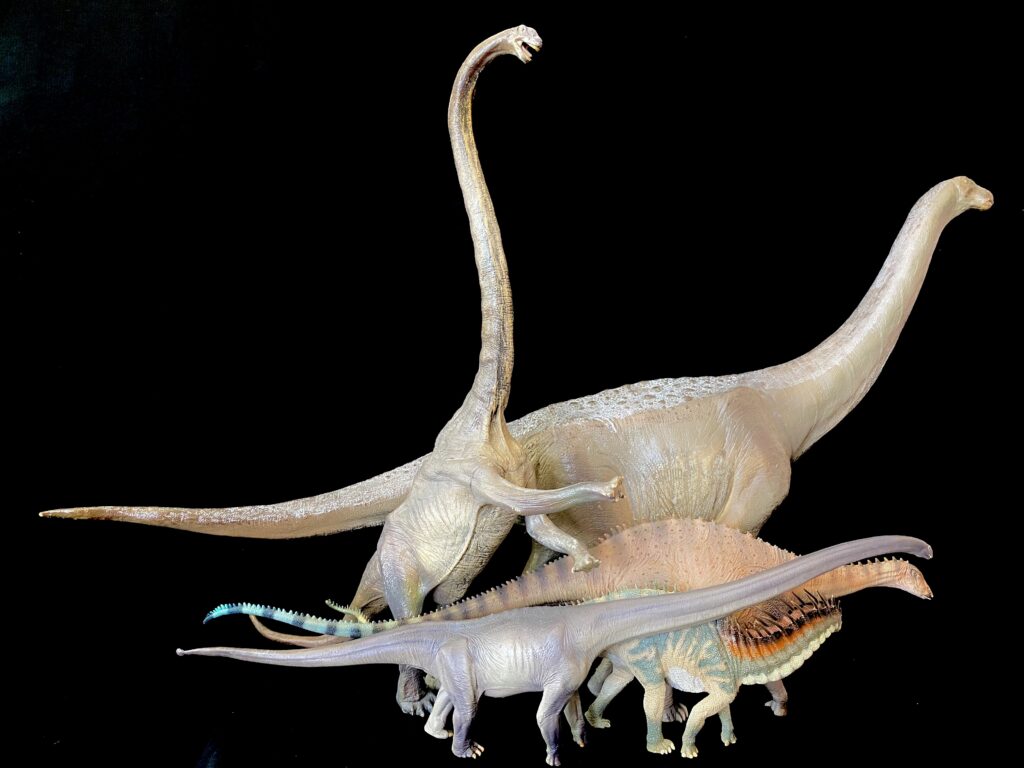
In closing, I find the addition of this obscure sauropod a very welcome and exciting one to PNSO’s already impressive collection. The choice of producing a sauropod from this fascinating family is a nice compromise in terms of size and cost. I’m glad that PNSO decided to release it as part of their standard set instead of the Museum Line, it makes the model more affordable.
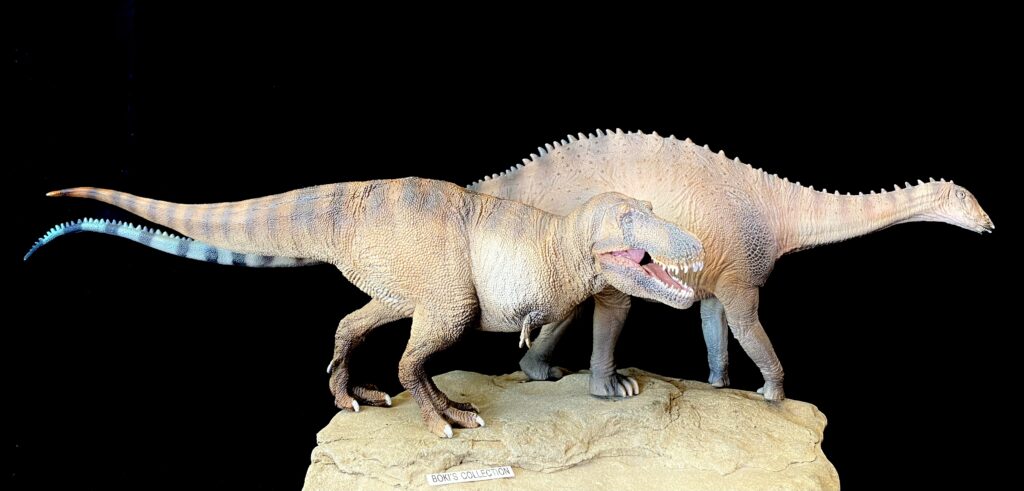
I personally hope that the release of this model is just the beginning, that PNSO(and other brands) will produce more sauropods in this size and scale in the near future. Who knows, maybe one day PNSO will surprise us and make more members of this unique and fascinating group of sauropods! Until then, we have this beautiful model to admire.
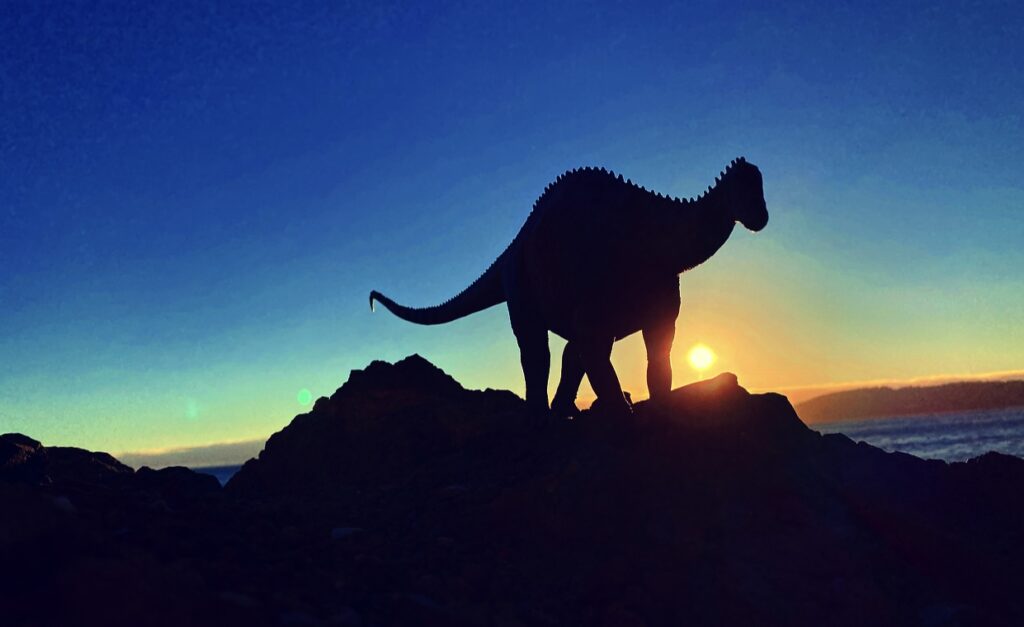
That concludes our review, thanks for reading. Until the next one, stay safe and healthy. Cheers!
Disclaimer: links to Ebay and Amazon on the DinoToyBlog are affiliate links, so we make a small commission if you use them. Thanks for supporting us!





That sure is one dramatic Bajadasaurus, Bokisaurus. I see that it didn’t appear on your DTB review of Bajadasaurus. Is that an entirely new figure that you repainted, or did you revisit a previous repaint? Impressive, in any case.
SidB, haha, I can’t believe the repainted Bajadasaurus turned out to be a scene stealer! Haha, yes, this one was a newer repaint, it was inspired by a commission I did, I loved it so much I decided to repaint one similar but not exactly alike.
One day I’ll try and post photos on my thread. Cheers!
For me, this is the stand-out model of 2022. Your review, Bokisaurus, does full justice to its beauty. Your photos are always good but you have surpassed your own high standard with these outdoor photoshoot images. Hard to choose a favourite from them but I love A New Queen Arrives for the blurry “ Cretaceous bird” – or is it a pterosaur? – flying in the background. And the richness of the colours in The Secret of Growing Big. That in fact is what is so striking about all the outdoor shots – the gloriously saturated warm colours; and the fabulous cloud formations. Thank you!
You are so kind, thank you! I’m glad you enjoyed the photos, I was able to take the model with me on my vacation to one of my favorite places in the Oregon coast. I really was aiming to capture the grandness of the model.
And yes, that is a bird on that photo, a pelican! I was able to capture just one as it flew over, they really do look like a pterosaur, a perfect substitute! Haha.
Much larger than I thought! Wonderful review as always.
It is huge and well detailed. It is worth buying that figure even if the price is high, its quality deserves it.
Thank you! I agree, it is well worth the cost, it’s an amazing model.